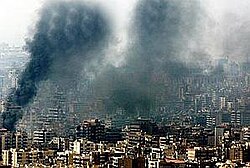It has been suggested that this article be merged into 2006 Lebanon War photographs controversies. (Discuss) Proposed since September 2024. |



The Adnan Hajj photographs controversy (also called Reutersgate) involves digitally manipulated photographs taken by Adnan Hajj, a Lebanese freelance photographer based in the Middle East, who had worked for Reuters over a period of more than ten years. Hajj's photographs were presented as part of Reuters' news coverage of the 2006 Lebanon War, but Reuters has admitted that at least two were significantly altered before being published.[1][2]
- ^ "Reuters toughens rules after altered photo affair". Reuters. 2007-01-18.
The two photos, both of Israeli military action in Lebanon during the war there last August, were taken by a freelance photographer, Adnan Hajj. Reuters ended its relationship with Hajj following an initial inquiry soon after bloggers questioned whether the photographs had been digitally altered using Photoshop software. All Hajj's images were removed from the Reuters Pictures sales database.
- ^ "Smoke and Mirrors: Reuters Dismisses Photog Over Doctored Beirut Picture". Editor and Publisher. August 6, 2006. Archived from the original on 8 September 2006. Retrieved 2006-08-07.